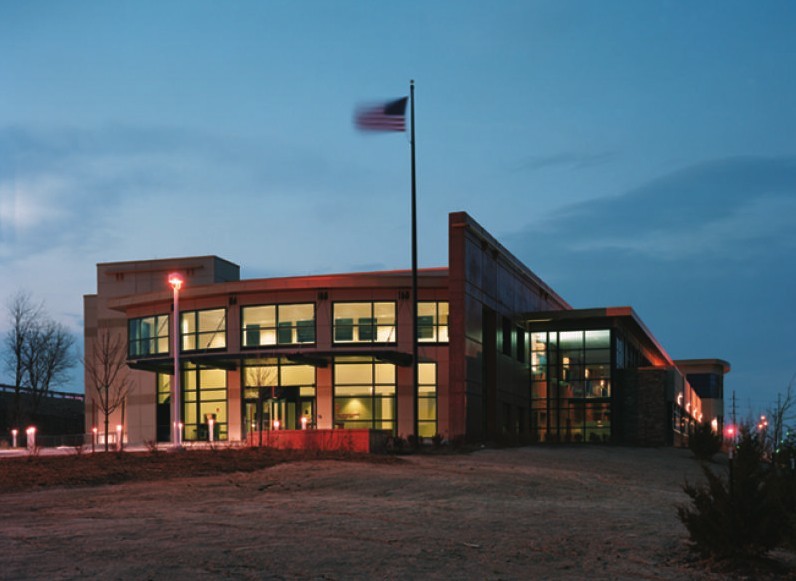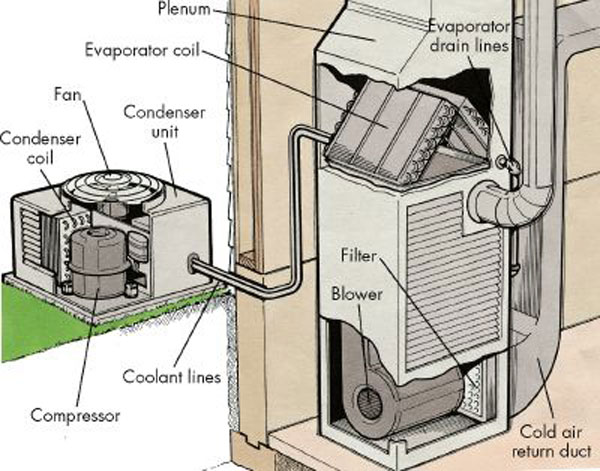|
Infiltration (HVAC)
Infiltration is the unintentional or accidental introduction of outside air into a building, typically through cracks in the building envelope and through use of doors for passage. Infiltration is sometimes called air leakage. The leakage of room air out of a building, intentionally or not, is called exfiltration. Infiltration is caused by wind, negative pressurization of the building, and by air buoyancy forces known commonly as the stack effect. Infiltration measures The infiltration rate is the volumetric flow rate of outside air into a building, typically in cubic feet per minute (CFM) or liters per second (LPS). The air exchange rate, (''I''), is the number of interior volume air changes that occur per hour, and has units of 1/h. The air exchange rate is also known as air changes per hour (''ACH''). ACH is the hourly ventilation rate, divided by the building volume. It can be calculated by multiplying the building's CFM by 60, and then dividing by the building volume. ... [...More Info...] [...Related Items...] OR: [Wikipedia] [Google] [Baidu] |
ASHRAE Handbook
The ASHRAE Handbook is the four-volume flagship publication of the nonprofit technical organization ASHRAE (American Society of Heating, Refrigerating and Air-Conditioning Engineers). This Handbook is considered the most comprehensive and authoritative repository of practical knowledge on the various topics that form the field of heating, ventilation, air-conditioning, and refrigeration ( HVAC&R). The four volumes are ''Fundamentals'', ''Refrigeration'', ''HVAC Applications'' ("Applications"), and ''HVAC Systems and Equipment'' ("Systems and Equipment"). Members of ASHRAE receive the current volume, in both print and CD-ROM form, each year as a basic membership benefit. An enhanced electronic version, known as ''ASHRAE Handbook Online'' is a web-based version updated annually that contains the four latest volumes as well as extra content such as calculations, demonstration videos, and spreadsheets. The various versions of the Handbook are typically available to the public v ... [...More Info...] [...Related Items...] OR: [Wikipedia] [Google] [Baidu] |
Energy Savings
Energy conservation is the effort to reduce wasteful energy consumption by using fewer energy services. This can be done by using energy more effectively (using less and better sources of energy for continuous service) or changing one's behavior to use less and better source of service (for example, by driving vehicles which consume renewable energy or energy with more efficiency). Energy conservation can be achieved through efficient energy use, which has some advantages, including a reduction in greenhouse gas emissions and a smaller carbon footprint, as well as cost, water, and energy savings. Green engineering practices improve the life cycle of the components of machines which convert energy from one form into another. Energy can be conserved by reducing waste and losses, improving efficiency through technological upgrades, improving operations and maintenance, changing users' behaviors through user profiling or user activities, monitoring appliances, shifting load to off ... [...More Info...] [...Related Items...] OR: [Wikipedia] [Google] [Baidu] |
Green Building
Green building (also known as green construction, sustainable building, or eco-friendly building) refers to both a structure and the application of processes that are environmentally responsible and resource-efficient throughout a building's life-cycle: from planning to design, construction, operation, maintenance, renovation, and demolition. This requires close cooperation of the contractor, the architects, the engineers, and the client at all project stages.Yan Ji and Stellios Plainiotis (2006): Design for Sustainability. Beijing: China Architecture and Building Press. The Green Building practice expands and complements the classical building design concerns of economy, utility, durability, and comfort. Green building also refers to saving resources to the maximum extent, including energy saving, land saving, water saving, material saving, etc., during the whole life cycle of the building, protecting the environment and reducing pollution, providing people with healthy, comfor ... [...More Info...] [...Related Items...] OR: [Wikipedia] [Google] [Baidu] |
Architectural Engineering
Architectural engineering or architecture engineering, also known as building engineering, is a discipline that deals with the engineering and construction of buildings, such as environmental, structural, mechanical, electrical, computational, embeddable, and other research domains. It is related to Architecture, Mechatronics Engineering, Computer Engineering, Aerospace Engineering, and Civil Engineering, but distinguished from Interior Design and Architectural Design as an art and science of designing infrastructure through these various engineering disciplines, from which properly align with many related surrounding engineering advancements. From reduction of greenhouse gas emissions to the construction of resilient buildings, architectural engineers are at the forefront of addressing several major challenges of the 21st century. They apply the latest scientific knowledge and technologies to the design of buildings. Architectural engineering as a relatively new licensed profe ... [...More Info...] [...Related Items...] OR: [Wikipedia] [Google] [Baidu] |
Mechanical Engineering
Mechanical engineering is the study of physical machines and mechanism (engineering), mechanisms that may involve force and movement. It is an engineering branch that combines engineering physics and engineering mathematics, mathematics principles with materials science, to design, analyze, manufacture, and maintain mechanical systems. It is one of the oldest and broadest of the List of engineering branches, engineering branches. Mechanical engineering requires an understanding of core areas including mechanics, Analytical dynamics, dynamics, thermodynamics, materials science, design, structural analysis, and electricity. In addition to these core principles, mechanical engineers use tools such as computer-aided design (CAD), computer-aided manufacturing (CAM), computer-aided engineering (CAE), and product lifecycle management to design and analyze manufacturing plants, industrial equipment and industrial machinery, machinery, HVAC, heating and cooling systems, transport systems, ... [...More Info...] [...Related Items...] OR: [Wikipedia] [Google] [Baidu] |
Psychrometrics
Psychrometrics (or psychrometry, ; also called hygrometry) is the field of engineering concerned with the physical and thermodynamic properties of gas-vapor mixtures. History With the inventions of the hygrometer and thermometer, the theories of combining the two began to emerge during the sixteenth and seventeenth centuries. In 1818, a German inventor, Ernst Ferdinand August (1795-1870), patented the term “psychrometer”, from the Greek language meaning “cold measure”. The psychrometer is a hygrometer, hygrometric instrument based on the principle that dry air enhances evaporation, unlike wet air, which slows it. Common applications Although the principles of psychrometry apply to any physical system consisting of gas-vapor mixtures, the most common system of interest is the mixture of water vapor and air, because of its application in HVAC, heating, ventilation, and air-conditioning and meteorology. In human terms, our thermal comfort is in large part a consequence ... [...More Info...] [...Related Items...] OR: [Wikipedia] [Google] [Baidu] |
Sick Building Syndrome
Sick building syndrome (SBS) is a condition in which people develop symptoms of illness or become infected with chronic disease from the building in which they work or reside. In scientific literature, SBS is also known as building-related illness (BRI), building-related symptoms (BRS), or idiopathic environmental intolerance (IEI). The main identifying observation is an increased incidence of complaints of such symptoms as headache, eye, nose, and throat irritation, fatigue, dizziness, and nausea. The 1989 Oxford English Dictionary defines SBS in that way. The World Health Organization created a 484-page tome on indoor air quality in 1984, when SBS was attributed only to non-organic causes, and suggested that the book might form a basis for legislation or litigation. The outbreaks may or may not be a direct result of inadequate or inappropriate cleaning. SBS has also been used to describe staff concerns in post-war buildings with faulty building aerodynamics, construction m ... [...More Info...] [...Related Items...] OR: [Wikipedia] [Google] [Baidu] |
Thermal Comfort
Thermal comfort is the condition of mind that expresses subjective satisfaction with the thermal environment.ANSI/ASHRAE Standard 55-2017, Thermal Environmental Conditions for Human Occupancy The human body can be viewed as a heat engine where food is the input energy. The human body will release excess heat into the environment, so the body can continue to operate. The heat transfer is proportional to temperature difference. In cold environments, the body loses more heat to the environment and in hot environments the body does not release enough heat. Both the hot and cold scenarios lead to discomfort. Maintaining this standard of thermal comfort for occupants of buildings or other enclosures is one of the important goals of HVAC ( heating, ventilation, and air conditioning) design engineers. Thermal neutrality is maintained when the heat generated by human metabolism is allowed to dissipate, thus maintaining thermal equilibrium with the surroundings. The main factors that in ... [...More Info...] [...Related Items...] OR: [Wikipedia] [Google] [Baidu] |
Indoor Air Quality
Indoor air quality (IAQ) is the air quality within buildings and Nonbuilding structure, structures. Poor indoor air quality due to indoor air pollution is known to affect the health, comfort, and well-being of building occupants. It has also been linked to Sick Building Syndrome, sick building syndrome, respiratory issues, reduced productivity, and impaired learning in schools. Common pollutants of indoor air include: Passive smoking, secondhand tobacco smoke, Household air pollution, air pollutants from indoor combustion, radon, Mold health issues, molds and other allergens, carbon monoxide, volatile organic compounds, legionella and other bacteria, Asbestos, asbestos fibers, carbon dioxide, ozone and Atmospheric particulate matter, particulates. Source control, filtration, and the use of ventilation (architecture), ventilation to dilute contaminants are the primary methods for improving indoor air quality. Although ventilation is an integral component of maintaining good indoo ... [...More Info...] [...Related Items...] OR: [Wikipedia] [Google] [Baidu] |
Natural Ventilation
Passive ventilation is the process of supplying air to and removing air from an indoor space without using mechanical systems. It refers to the flow of external air to an indoor space as a result of pressure differences arising from natural forces. There are two types of natural ventilation occurring in buildings: '' wind driven ventilation'' and ''buoyancy-driven ventilation''. Wind driven ventilation arises from the different pressures created by wind around a building or structure, and openings being formed on the perimeter which then permit flow through the building. Buoyancy-driven ventilation occurs as a result of the directional buoyancy force that results from temperature differences between the interior and exterior. Since the internal heat gains which create temperature differences between the interior and exterior are created by natural processes, including the heat from people, and wind effects are variable, naturally ventilated buildings are sometimes called "bre ... [...More Info...] [...Related Items...] OR: [Wikipedia] [Google] [Baidu] |
Weatherization
Weatherization (American English) or weatherproofing (British English) is the practice of protecting a building and its interior from the elements, particularly from sunlight, precipitation, and wind, and of modifying a building to reduce energy consumption and optimize energy efficiency. Weatherization is distinct from building insulation, although building insulation requires weatherization for proper functioning. Many types of insulation can be thought of as weatherization, because they block drafts or protect from cold winds. Whereas insulation primarily reduces ''conductive'' heat flow, weatherization primarily reduces ''convective'' heat flow. In the United States, buildings use one third of all energy consumed and two thirds of all electricity. Due to the high energy usage, they are a major source of the pollution that causes urban air quality problems and pollutants that contribute to climate change. Building energy usage accounts for 49 percent of sulfur dioxide e ... [...More Info...] [...Related Items...] OR: [Wikipedia] [Google] [Baidu] |
HVAC
Heating, ventilation, and air conditioning (HVAC ) is the use of various technologies to control the temperature, humidity, and purity of the air in an enclosed space. Its goal is to provide thermal comfort and acceptable indoor air quality. HVAC system design is a subdiscipline of mechanical engineering, based on the principles of thermodynamics, fluid mechanics, and heat transfer. "Refrigeration" is sometimes added to the field's abbreviation as HVAC&R or HVACR, or "ventilation" is dropped, as in HACR (as in the designation of HACR-rated circuit breakers). HVAC is an important part of residential structures such as single family homes, apartment buildings, hotels, and senior living facilities; medium to large industrial and office buildings such as skyscrapers and hospitals; vehicles such as cars, trains, airplanes, ships and submarines; and in marine environments, where safe and healthy building conditions are regulated with respect to temperature and humidity, using fres ... [...More Info...] [...Related Items...] OR: [Wikipedia] [Google] [Baidu] |







